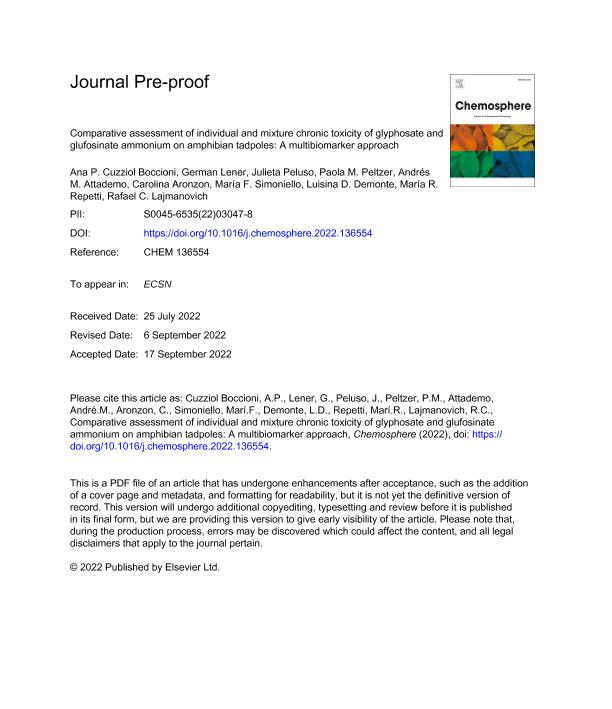Artículo
Comparative assessment of individual and mixture chronic toxicity of glyphosate and glufosinate ammonium on amphibian tadpoles: A multibiomarker approach
Cuzziol Boccioni, Ana Paula ; Lener, German
; Lener, German ; Peluso, Julieta
; Peluso, Julieta ; Peltzer, Paola
; Peltzer, Paola ; Attademo, Andres Maximiliano
; Attademo, Andres Maximiliano ; Aronzon, Carolina Mariel
; Aronzon, Carolina Mariel ; Simoniello, Maria Fernanda; Demonte, Luisina Delma
; Simoniello, Maria Fernanda; Demonte, Luisina Delma ; Repetti, María Rosa; Lajmanovich, Rafael Carlos
; Repetti, María Rosa; Lajmanovich, Rafael Carlos
 ; Lener, German
; Lener, German ; Peluso, Julieta
; Peluso, Julieta ; Peltzer, Paola
; Peltzer, Paola ; Attademo, Andres Maximiliano
; Attademo, Andres Maximiliano ; Aronzon, Carolina Mariel
; Aronzon, Carolina Mariel ; Simoniello, Maria Fernanda; Demonte, Luisina Delma
; Simoniello, Maria Fernanda; Demonte, Luisina Delma ; Repetti, María Rosa; Lajmanovich, Rafael Carlos
; Repetti, María Rosa; Lajmanovich, Rafael Carlos
Fecha de publicación:
12/2022
Editorial:
Pergamon-Elsevier Science Ltd
Revista:
Chemosphere
ISSN:
0045-6535
Idioma:
Inglés
Tipo de recurso:
Artículo publicado
Clasificación temática:
Resumen
The aim of the present study was to assess the ecotoxicity of glyphosate and glufosinate ammonium mixtures on amphibian tadpoles and the potential impact of mixture in aquatic ecosystems health. The bonding properties of the mixture based on computational chemistry and an experimental bioassay on morphology, DNA damage and biochemical biomarkers on tadpoles of the common toad Rhinella arenarum were studied. The results of the density functional theory analysis showed trends of the pesticides clustering to form exothermic mixtures, suggesting the likelihood of hot-spots of pesticides in real aquatic systems. In addition, biological effects of individual pesticides and the mixture were studied on tadpoles over 45 days-chronic bioassay. The bioassay consisted of four treatments: a negative control (CO), 2.5 mg L-1 of a glyphosate-based herbicide (GBH), 2.5 mg L-1 of a glufosinate ammonium-based herbicide (GABH) and their 50:50 (% v/v) mixture (GBH-GABH). Morphological abnormality rates were significantly higher in all herbicide treatments with respect to CO at 48 h of exposure. Abdominal edema was the most frequent type of abnormality recorded at 48 h, 10 and 45 days of exposure. DNA damage was recorded in all herbicides treatments. Thyroxin increased only in GABH treatment. Acetylcholinesterase (AChE) and butyrylcholinesterase (BChE) significantly increased in GBH treatment, indicating a GBH-neurotoxic effect. Glutathione S-transferase decreased in GABH and GBH-GABH treatments, while catalase decreased in individual GBH and GABH treatments. Overall, teratogenicity, DNA damage, hormonal disruption (T4), and oxidative stress were greater in GABH-treated tadpoles than GBH-treated tadpoles. This study also highlights the robust chemical interaction between the active ingredients of both herbicides, which is reflected on antagonisms in most of analyzed biomarkers, as well as potentiation and additivity in others. Based on our results, the GABH had a higher toxicity than GBH for amphibian tadpoles.
Archivos asociados
Licencia
Identificadores
Colecciones
Articulos (IIIA)
Articulos de INSTITUTO DE INVESTIGACION E INGENIERIA AMBIENTAL
Articulos de INSTITUTO DE INVESTIGACION E INGENIERIA AMBIENTAL
Articulos(INFIQC)
Articulos de INST.DE INVESTIGACIONES EN FISICO- QUIMICA DE CORDOBA
Articulos de INST.DE INVESTIGACIONES EN FISICO- QUIMICA DE CORDOBA
Citación
Cuzziol Boccioni, Ana Paula; Lener, German; Peluso, Julieta; Peltzer, Paola; Attademo, Andres Maximiliano; et al.; Comparative assessment of individual and mixture chronic toxicity of glyphosate and glufosinate ammonium on amphibian tadpoles: A multibiomarker approach; Pergamon-Elsevier Science Ltd; Chemosphere; 309; 12-2022; 1-12
Compartir
Altmétricas



